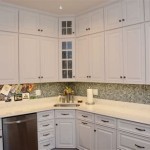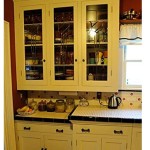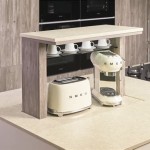Kitchen Distressed Gray Cabinets: A Comprehensive Guide
Distressed gray cabinets have emerged as a popular trend in kitchen design, offering a unique blend of rustic charm and contemporary sophistication. This style combines the versatility of gray tones with the aged, weathered look achieved through distressing techniques. The result is a cabinet finish that adds character and visual interest to any kitchen space. The following explores the elements of distressed gray kitchen cabinets, covering their benefits, design considerations, and maintenance requirements.
Understanding the Appeal of Distressed Gray
The popularity of distressed gray cabinets stems from several factors. First, gray is a neutral color that complements a wide range of design styles and color palettes. It serves as a versatile backdrop for various countertops, backsplashes, and flooring options. Second, the distressed finish introduces texture and visual depth, preventing the cabinets from appearing flat or monotonous. The imperfections and variations inherent in distressing create a sense of history and authenticity, lending a lived-in feel to the kitchen.
Furthermore, distressed gray cabinets offer a compromise between traditional and modern aesthetics. They can be incorporated into farmhouse kitchens, contemporary designs, and transitional spaces, adding a touch of rustic elegance without appearing overly outdated. The gray tones keep the look current, while the distressing provides a vintage touch.
The appeal also lies in the inherent practicality of the finish. Distressing can subtly conceal minor imperfections and wear and tear, making the cabinets more forgiving in high-traffic areas. This can be especially beneficial in households with children or pets, where scratches and dings are more likely to occur.
Design Considerations for Distressed Gray Cabinets
When designing a kitchen with distressed gray cabinets, several key considerations must be taken into account. These factors include the specific shade of gray, the type and extent of the distressing, and the overall style of the kitchen. Careful planning and attention to detail are essential to ensure a cohesive and visually appealing result.
The selection of the gray tone is crucial. Lighter grays tend to create a more airy and contemporary feel, while darker grays evoke a sense of warmth and sophistication. The choice of gray should be guided by the size of the kitchen, the amount of natural light, and the desired overall aesthetic. For smaller kitchens, lighter grays are often preferred to avoid making the space feel cramped or dark. In larger kitchens, darker grays can be used to create a more dramatic and intimate atmosphere.
The distressing technique also plays a significant role in the final look of the cabinets. Different types of distressing can achieve varying degrees of wear and tear. Some techniques involve creating subtle scratches and dents, while others include more pronounced chipping and weathering. The level of distressing should be carefully considered to ensure it complements the overall style of the kitchen. Overly distressed cabinets may appear out of place in a modern kitchen, while lightly distressed cabinets may not provide enough visual interest in a more rustic setting.
Consideration must be given to the hardware chosen for the cabinets. Oil-rubbed bronze, antique brass, or black hardware can enhance the rustic appeal of distressed gray cabinets, while polished nickel or chrome hardware can add a touch of modern elegance. The hardware should complement the style of the cabinets and the overall design of the kitchen.
Further considerations include the countertop material, backsplash design, and flooring options. Granite, quartz, and marble countertops can all work well with distressed gray cabinets, depending on the specific shade of gray and the desired aesthetic. A subway tile backsplash can create a classic and timeless look, while a more contemporary backsplash can add a modern touch. Wood flooring can enhance the warmth and rustic charm of the kitchen, while tile or stone flooring can provide a more durable and low-maintenance option.
The integration of other kitchen elements, such as open shelving and kitchen islands, also requires careful consideration. Open shelving can provide an opportunity to display decorative items and add visual interest to the kitchen, while a kitchen island can serve as a functional workspace and a focal point. The design of these elements should complement the distressed gray cabinets and contribute to the overall cohesive look of the kitchen.
Implementing Distressing Techniques
Distressing techniques vary greatly, each producing a unique look. Some common methods include sanding, chipping, glazing, and dry brushing. The choice of technique will depend on the desired level of distress and the type of cabinet material.
Sanding is a fundamental technique used to remove portions of the cabinet's finish, revealing the underlying wood. This can be done manually with sandpaper or with power tools such as a sanding block or orbital sander. The amount of pressure applied and the grit of the sandpaper will determine the extent of the distressing. Sanding is often used around edges and corners to create a worn appearance.
Chipping involves creating small imperfections and chips in the cabinet's finish. This can be achieved with tools such as a chisel, a screwdriver, or even a hammer. The chips should be applied randomly and sparingly to create a natural and authentic look. Chipping is often used to mimic the wear and tear that occurs over time.
Glazing involves applying a thin layer of tinted glaze to the cabinet's surface and then wiping it away, leaving the glaze in crevices and details. This technique can add depth and dimension to the cabinet's finish, highlighting the texture and imperfections. Glazing is particularly effective on cabinets with raised panel doors or intricate detailing.
Dry brushing involves applying a small amount of paint to a dry brush and then lightly brushing it across the cabinet's surface. This technique can create a subtle streaked effect that adds texture and visual interest. Dry brushing is often used to highlight the edges and corners of the cabinets, creating a worn and weathered appearance.
Before implementing any distressing technique, it is essential to prepare the cabinet surface properly. This typically involves cleaning the cabinets thoroughly and sanding them lightly to create a smooth and even surface. It is also important to protect the surrounding areas with drop cloths or masking tape to prevent damage. Safety precautions, such as wearing a mask and gloves, should be taken when working with paints and other finishing materials.
Care and Maintenance of Distressed Gray Cabinets
While distressed gray cabinets are relatively durable and forgiving, proper care and maintenance are essential to ensure their longevity and preserve their beauty. Regular cleaning and occasional touch-ups can help keep the cabinets looking their best for years to come.
Regular cleaning should be performed with a mild soap and water solution. Avoid using harsh chemicals or abrasive cleaners, as these can damage the finish. A soft cloth or sponge should be used to gently wipe down the cabinets, removing any dirt or grime. It is important to dry the cabinets thoroughly after cleaning to prevent water damage.
For stubborn stains or spills, a slightly stronger cleaning solution may be necessary. However, it is important to test the solution in an inconspicuous area first to ensure it does not damage the finish. A mixture of white vinegar and water can be effective for removing grease and grime, while a baking soda paste can be used to remove stubborn stains.
Occasional touch-ups may be necessary to repair minor scratches or chips in the finish. A touch-up paint or stain that matches the color of the cabinets can be used to conceal the imperfections. Apply the touch-up paint or stain sparingly and blend it carefully with the surrounding area. For larger repairs, it may be necessary to consult with a professional cabinet refinisher.
To prevent damage to the cabinets, avoid slamming the doors or drawers. Use felt pads on the inside of the doors and drawers to cushion the impact. Keep the cabinets free of clutter and avoid placing heavy objects on the shelves. Excessive weight can cause the shelves to sag or break.
Maintaining a consistent humidity level in the kitchen can also help prevent damage to the cabinets. Excessive humidity can cause the wood to swell and warp, while excessive dryness can cause it to crack or shrink. A dehumidifier or humidifier can be used to maintain the optimal humidity level.
The Cost Factor
The cost of distressed gray kitchen cabinets can vary widely, depending on several factors. The type of wood, the complexity of the design, the extent of the distressing, and the manufacturer all play a role in determining the final price. Generally, custom-made cabinets will be more expensive than stock cabinets, and more elaborate distressing techniques will add to the cost.
Homeowners should obtain quotes from multiple cabinet makers or retailers to compare prices and find the best value for their budget. It is also important to factor in the cost of installation, hardware, and any necessary modifications to the kitchen layout.
While distressed gray cabinets may represent a significant investment, they can add considerable value and appeal to a home. The unique blend of rustic charm and contemporary sophistication can create a kitchen that is both beautiful and functional.

Distressed Gray Cabinets Design Ideas

Gray Kitchen Cabinets Ready To Assemble

Cabinet Weathered Kitchen Cabinets Gray Black Distressed Painted Wood Grey Designs Glazed Design

20 Mind Blowing Gray Kitchen Cabinets Design Ideas Cuethat

How To Use Distressed Kitchen Cabinets Stylize Your Home

Distressed Gray Kitchen Cabinets Transitional Donna Benedetto Designs

Reform Space With Antiqued Kitchen Cabinets June 2025

The Perfect Shades Of Gray

12 Grey Kitchen Cabinets That Will Inspire And Delight You

Reclaimed Comfort St Louis Homes Lifestyles
Related Posts








